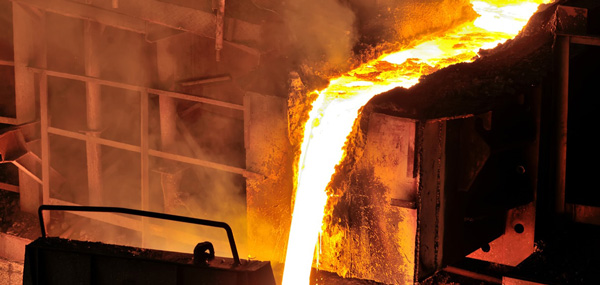Finding the right metalcasting method for your part can be challenging. With so many choices available, it becomes nearly impossible to pick the best method suited for you. Hence, in this article, types of metal casting are explained simply and clearly. So, you can choose the best method for your part with confidence. Let’s begin!
1) Understanding Metal Casting?
“Metal casting is the process of pouring molten metal into a mould, which is shaped to produce a particular object or part. After cooling, the metal solidifies in the shape of the desired part.”
Generally, you might have used cast products without realising their wide availability. These include car engines, tools, machine parts, and even some decorative pieces. However, it’s an efficient method for manufacturing both intricate and simple geometrical forms.
Basically, casting is done with the use of moulds made out of sand, metal, or ceramic. You know what? The shape of the mould determines the final shape of the metal part. Yes, after creating the mould, metal is subsequently melted and poured into the mould.
Thus, this method allows for the parts that are produced to be strong as well as can endure heavy loads while remaining exceptionally detailed. Additionally, it happens to be one of the most economical methods for producing metal components in bulk.
That’s why it has numerous applications within industries like automotive, aerospace, construction, as well as in artistic fields.
Why It Matters for You
Well, the most beneficial attribute of metal casting is its flexibility. Yes, you can use the many types of casting materials, including aluminium, iron, steel, bronze, and copper.
Furthermore, you have to know that different materials come with different properties, which is always beneficial when making a choice. For instance, aluminium is lightweight and does not corrode readily like other metals, while steel is known for its strength, and bronze offers a useful combination of good durability and an appealing look.
Well, along with material usage, there is also a variety of types of metal casting processes, each one designed for specific tasks. Some are ideal for big and heavy components, while others work best with thin-walled or intricate details. So, you have many options.
If you are not sure which method to select, there is an LTC Proto that can really help you. TLC proto professionals know the advantages and disadvantages of each type of casting and will assist you in every step of the journey. Moreover, we will ensure that whether it is prototypes or production runs, the right strategy is determined from the very beginning.
2) The Most Common Types of Metal Casting
Alright! While becoming familiar with metal parts, you should be aware that there are different methods available. Each type has an offering that is distinctively useful in its own way. Let’s discuss the main types of casting metal, so keep in touch!
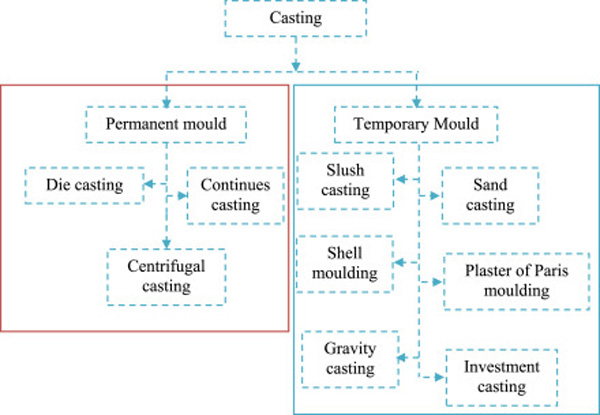
i) Sand Casting
Sand casting is the oldest and most popular method because it involves the use of a mould made from special sand. Once molten metal is poured into the mould and cooled down, the sand is broken away.
Additionally, this technique is ideal for large or complicated parts. Moreover, it also works well with many types of casting materials such as iron, steel, aluminium, and bronze. Well, the sand casting is cost-efficient and easy to use.
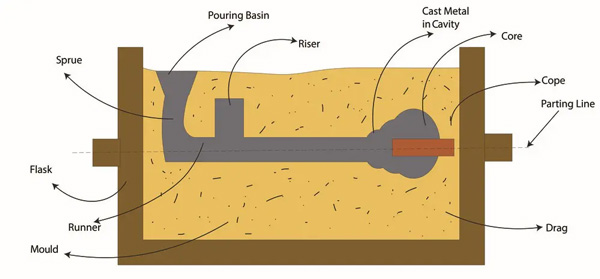
ii) Die Casting
Another type of metal casting is die casting. In this method, metal moulds are used, and the process is done by high pressure to shape the part. Moreover, these moulds are reusable, so they make the process fast and efficient.
When you need smooth surfaces and precision on dimensions, die casting is the best choice. It is most effective with non-ferrous metals such as aluminium, zinc, and magnesium. In addition to providing excellent results, it’s great for high-volume production.
iii) Investment Casting
Well, the investment casting is also known as lost-wax casting, because this method uses a wax pattern as its starting point. The wax is then coated with ceramic to form a mould which melts away when heated, and metal takes its place.
This method works best with small and intricate parts with detailed finishing. It can be used with steel, aluminium, and various other alloys. Furthermore, it is being used in aerospace, medical devices, and jewellery sectors.
iv) Shell Moulding
To be straightforward, shell moulding is an improvement over sand casting. It employs resin-coated sand, which makes smoother moulds than sand casting.
Moreover, it is suitable for medium-sized parts where detail and surface finish are important features. Hence, it improved repeatability and reduced material waste. Therefore, it is the best choice when you need efficiency at an affordable cost.
v) Centrifugal Casting
One of the more interesting methods would have to be centrifugal casting, since this technique pours molten metal into rotating moulds, creating centrifugal force. Thus, this centrifugal force helps fill the mold uniformly while eliminating air pockets and increases the strength.
Significantly, it is mostly used for round shapes such as pipes and rings. The outcome? Stronger, dependable parts with fewer defects. That’s why it is widespread in heavy industries, as well as power generation.
vi) Permanent Mold Casting
Another type of metal casting is permanent mould casting. In this method, sand or ceramic moulds are replaced with reusable metal ones. These moulds are coated and preheated before the filling of metal.
However, this type offers a better surface finish along with consistent accuracy. Moreover, it is best for medium to large production runs. One more thing: The common metals used in permanent mold casting include aluminium and magnesium alloys.
vii) Vacuum Casting
As the name suggests, vacuum casting uses a vacuum to draw metal into the mould. However, it aids in avoiding bubbles and defects. This is perfect for thin-walled or highly intricate parts where good quality is essential. So, this method is useful for prototypes, aerospace, and electronics.
viii) Plaster Mold Casting
Like sand casting, this process utilises plaster to create the mould. However, it gives more precise results and produces smoother surface parts. Moreover, plaster mould casting is used in Small to medium-sized components made from non-ferrous metals such as aluminium and zinc. It is best for detailed work with low costs.
ix) Lost Foam Casting
Well, instead of wax patterns, foam patterns are used in this process. When Molten metal fills the foam pattern, then the foam evaporates and the metal fills the space. It’s great for highly detailed or intricate shapes. However, it is used in automotive components and industrial machinery.
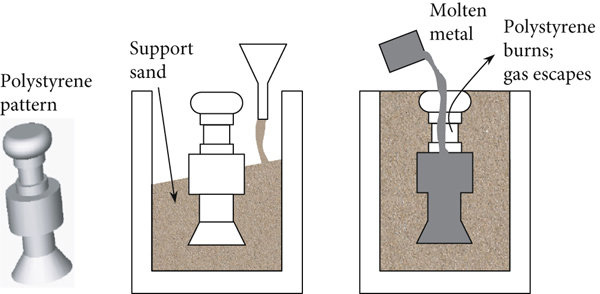
x) Squeeze Casting
Lastly, this technique is a combination of casting and forging. First, metal is poured into the mold, and then pressure is exerted onto it. This process enhances its strength and eliminates air pockets. Most importantly, Squeeze casting has extensive applications in manufacturing high-strength components such as gear brackets due to its use in the automotive industry.
In simple words, as you have seen the different types of metal casting, each type has its unique characteristics and advantages. So, whether your priority is size, detailing, or operational strength, there’s a method tailored for your needs.
Still, if you are having difficulties identifying which method is best for your parts requirements, get a quote from LTC Proto and find solutions.
3) Selecting the Right Casting Method for Your Part
Alright, having learned about different types of metal casting, now comes the challenge of selecting one suitable for your part design parameters. It can get tricky when every approach has something unique to offer. But worry not, that’s what we are here for!
Let us first highlight some critical factors that require consideration while choosing the right casting method for your part, so go ahead!
| Casting Method | Best For | Surface Finish | Cost | Volume | Common Metals |
| Sand Casting | Large, simple parts | Rough | Low | Low to High | Iron, Steel, Aluminium |
| Die Casting | High-volume, small parts | Smooth | High (initial) | High | Aluminium, Zinc, Magnesium |
| Investment Casting | Complex, detailed parts | Very Smooth | Medium to High | Low to Medium | Steel, Aluminium, Bronze |
| Shell Molding | Medium-sized, precise parts | Smooth | Medium | Medium | Iron, Aluminium, Steel |
| Centrifugal Casting | Round, dense parts | Fair | Medium to High | Medium | Steel, Bronze |
| Permanent Mold Casting | Repeatable, medium-sized parts | Good | Medium | Medium to High | Aluminium, Magnesium |
| Vacuum Casting | Thin-walled, precise parts | Excellent | Medium | Low to Medium | Specialty Alloys |
| Plaster Mold Casting | Small, intricate non-ferrous | Very Smooth | Low to Medium | Low | Aluminium, Zinc, Copper |
| Lost Foam Casting | Complex shapes, automotive use | Fair | Medium | Medium | Iron, Aluminium |
| Squeeze Casting | Strong, dense parts | Good | Medium to High | Medium | Aluminium, Magnesium |
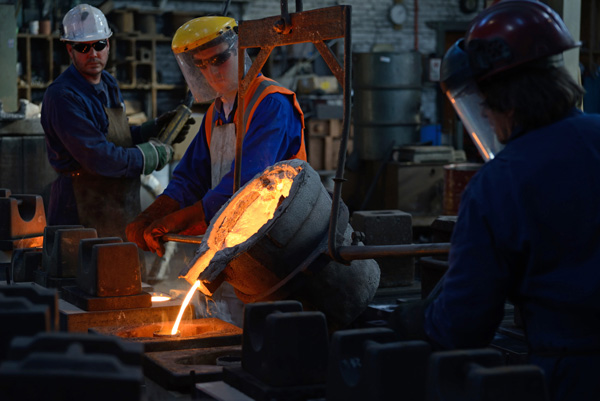
? Start with the Part’s Design: The first step to consider is your part’s shape, size, and details. If your design has thin walls or intricate features, you will need more delicate processes like investment or vacuum casting.
On the other hand, if your part is thick and bulky, sand casting or centrifugal casting are likely better options. You know these methods work well for large parts that do not require a finely polished surface.
? Think About Quantity: Are you making one part or many? For high production volumes, die casting and permanent mould casting offer rapid output. In addition, they offer consistent quality over time, making them a low-cost option in the long run.
In contrast, if you are looking to get custom parts made in smaller quantities, consider sand casting or investment casting. These provide greater flexibility while keeping initial costs down.
? Know Your Material: Some processes favour certain materials over others. For instance, if planning to use lightweight metals such as aluminium or zinc, then die and permanent mold castings would serve best.
Conversely, if you want to work with steel, iron, or bronze materials, then attention should be paid towards sand and investment castings as they suit these metals well. To ensure optimal results, it is important to align your preferred metal with the suitable casting process.
? Set Your Budget: Setting a budget is often the first step in narrowing down business options. For example, some processes, such as die casting, require expensive molds and are only cost-effective for long production runs. Other processes, like sand casting, are much cheaper for smaller projects.
On the other hand, if you’re looking for high-quality guidance without spending too much, Proto LTC has helpful options aligned with your needs. The team embraces all kinds of casting methods and materials.
? Do Not Forget The Finish: How a product looks and feels are very important factors to take into consideration. Do you know? Some casting methods create smooth surfaces while others will require machining or polishing to be performed.’
As for greater detail and finishing, both investment casting and die casting are preferred techniques. They provide good finishes and finer details right out of the mould.
4) Practical Tips on Selecting the Right Casting Method
Alright! If you want to be confident about your decision, some additional factors can tip the balance in your favour. So, let’s discuss some final tips on selecting the ridge casting method:
- Know Your Priorities First
Before selecting any method, you should consider what is most valuable to your project.
- Is a smooth surface a requirement?
- Is cost an issue?
- Are you looking for low-volume or high-volume production?
- Do you need tight tolerances or special materials?
Well, if you have determined all priorities first, it will be simple to choose options while making your choice. Just keep in mind that each project is different, so there isn’t a universal suitable approach for every project. What matters most is that the chosen method serves you best, instead of sounding appealing when read on paper.
- Match the Method with the Material
To be honest, every casting technique has specific metals with which they operate optimally, for example:
- Die casting is good for aluminium and zinc
- Sand casting holds perfection for iron and steel.
- Investment casting is particularly proficient with stainless steel and bronze.
Hence, you should always match your appropriate method to the types of casting materials you need. Thus, it helps you to avoid mistakes and costly delays.
- Don’t Overlook Production Volume
Most importantly, if hundreds or thousands of identical parts are needed, die casting or permanent mold casting are more cost-effective options. On the other hand, for only a few pieces and prototypes, sand casting and investment casting tend to be easier and quicker options.
- Work with a Trusted Casting Partner
This could be the most important tip of all, yes: collaborating with a reliable partner can simplify everything. A dependable casting partner like LTC Proto aids in reviewing your part, recommending suitable methods while ensuring high speed and accuracy throughout the process.
Hopefully, our years of expertise will ensure good quality while minimising stress for you.
5) Conclusion
Alright! Metal casting provides various techniques for every shape of a component, from basic to intricate shapes. By knowing material, volume, finishing options, as well as your project’s requirements, you can select the correct casting process with great assurance.
However, if you require expert guidance, LTC Proto comes highly recommended. We have advanced equipment, speedy service, and extensive experience on all primary casting types. Significantly, we provide easy access to high-quality results. You can contact us right now!
